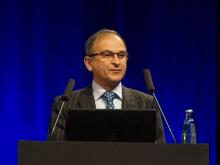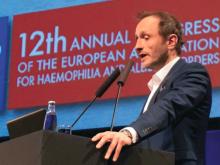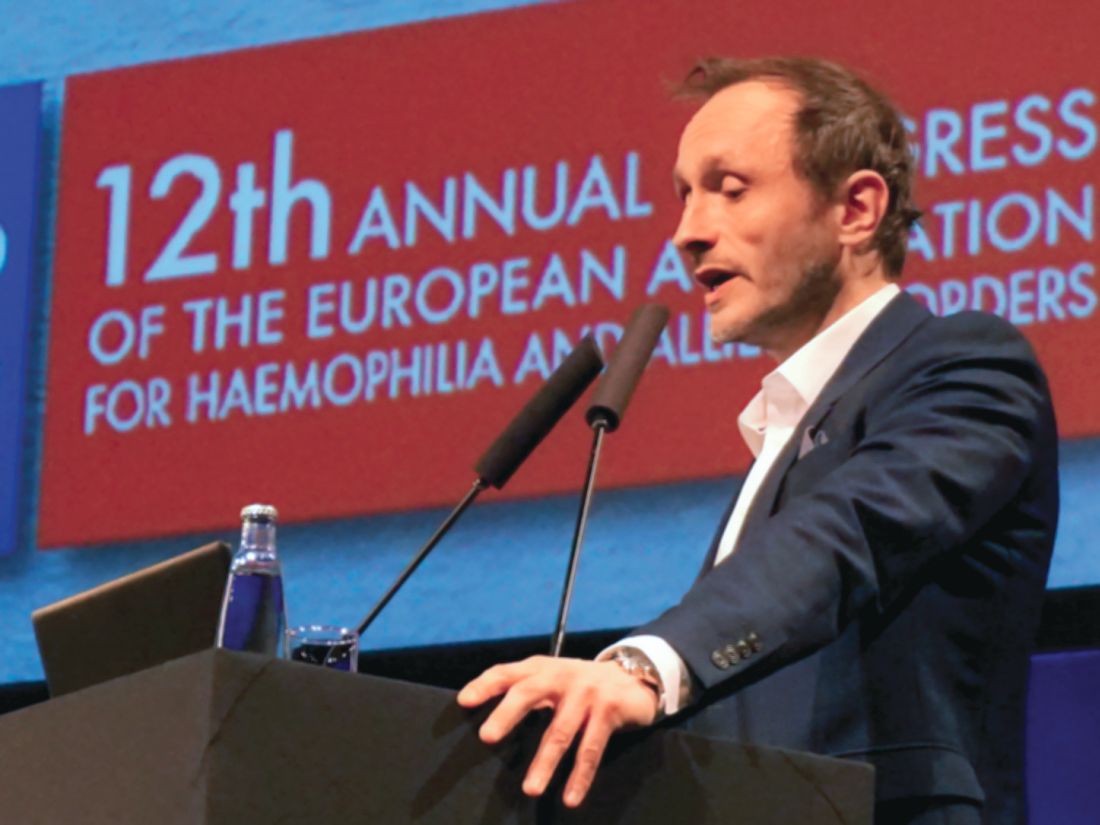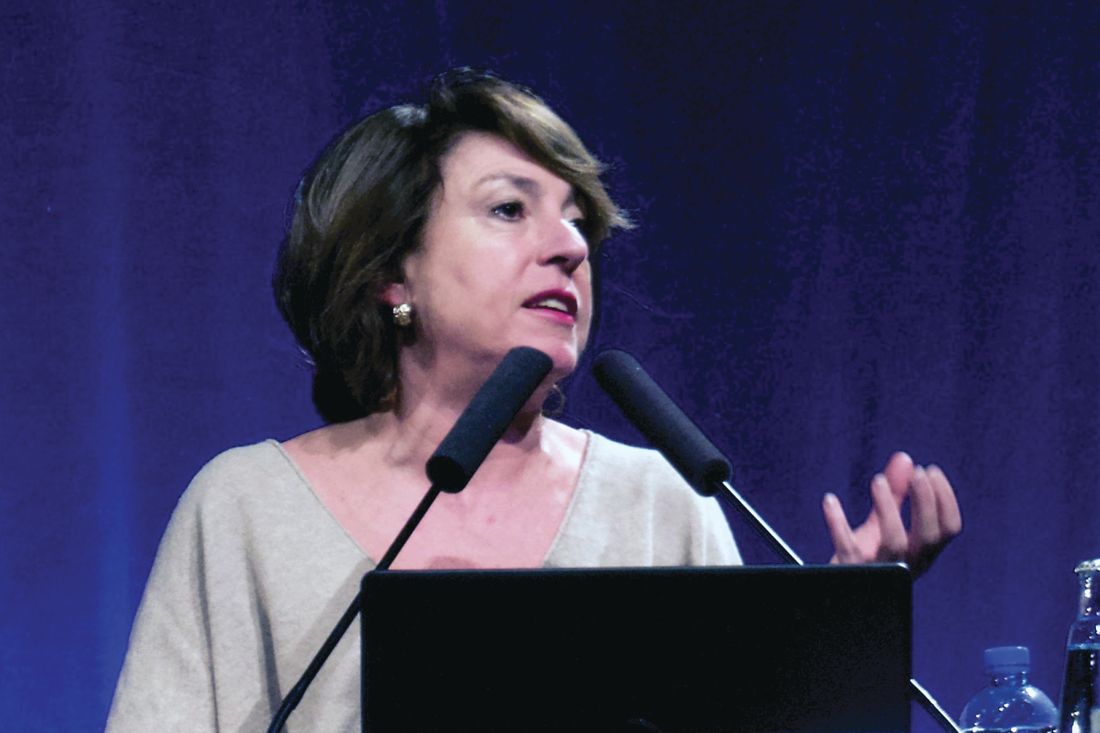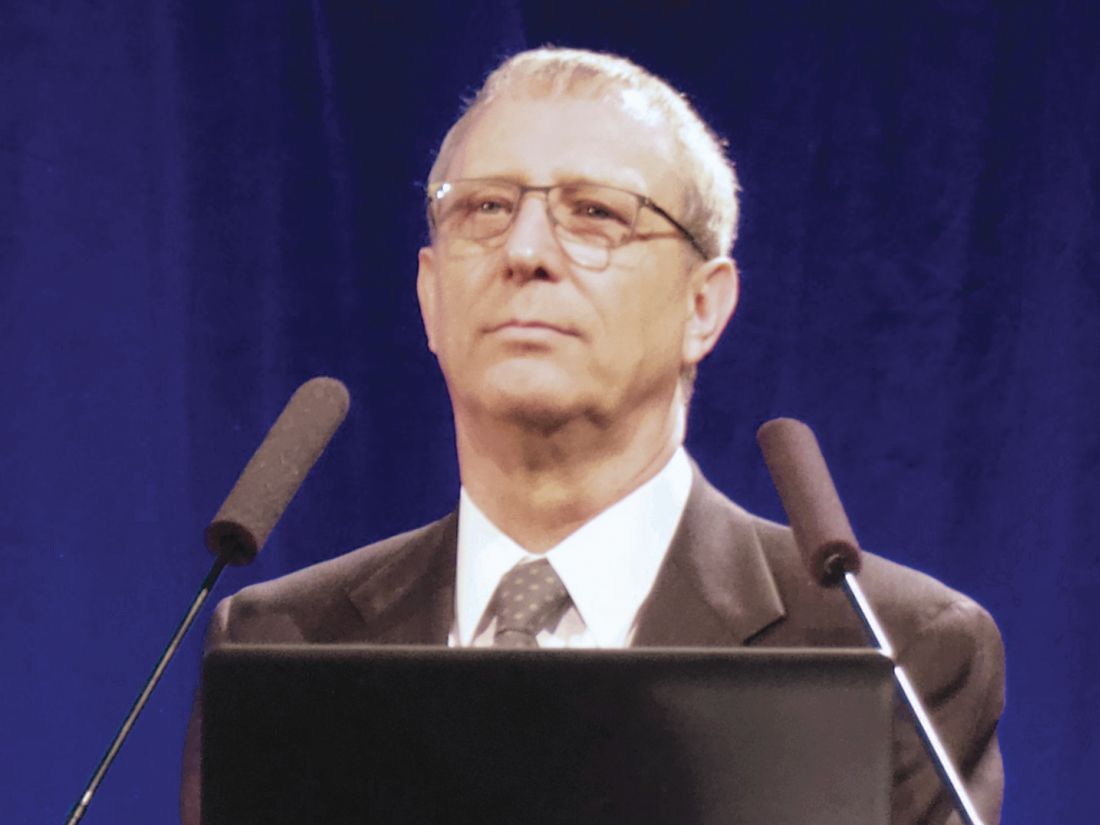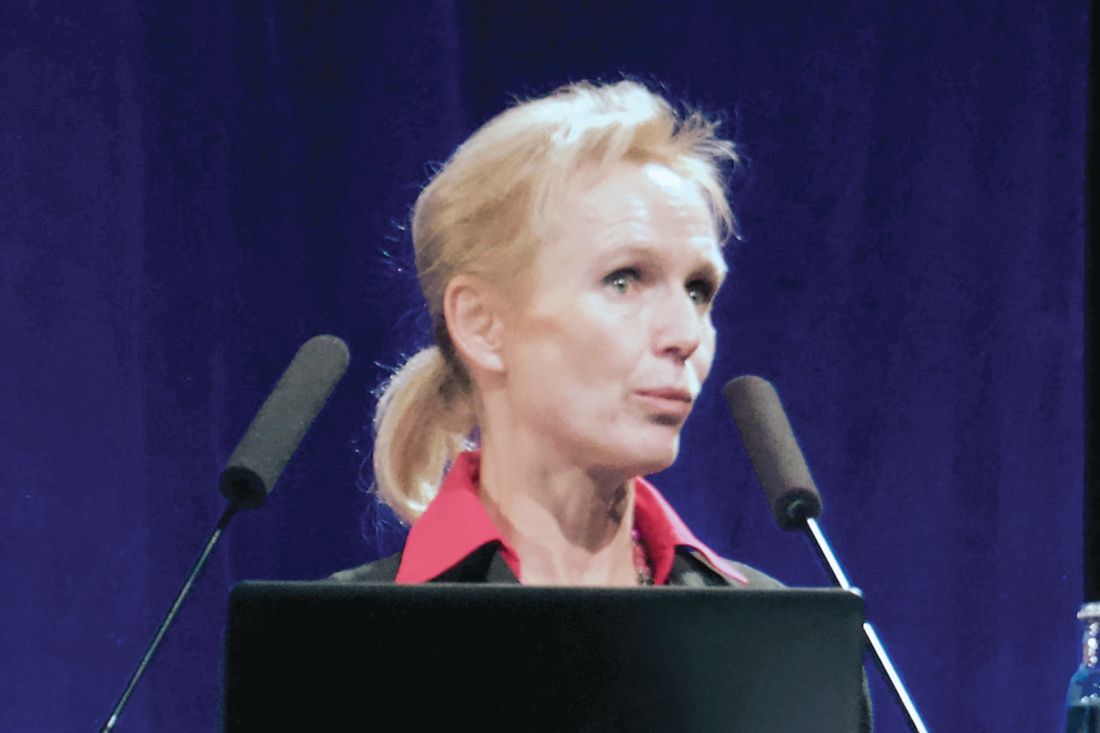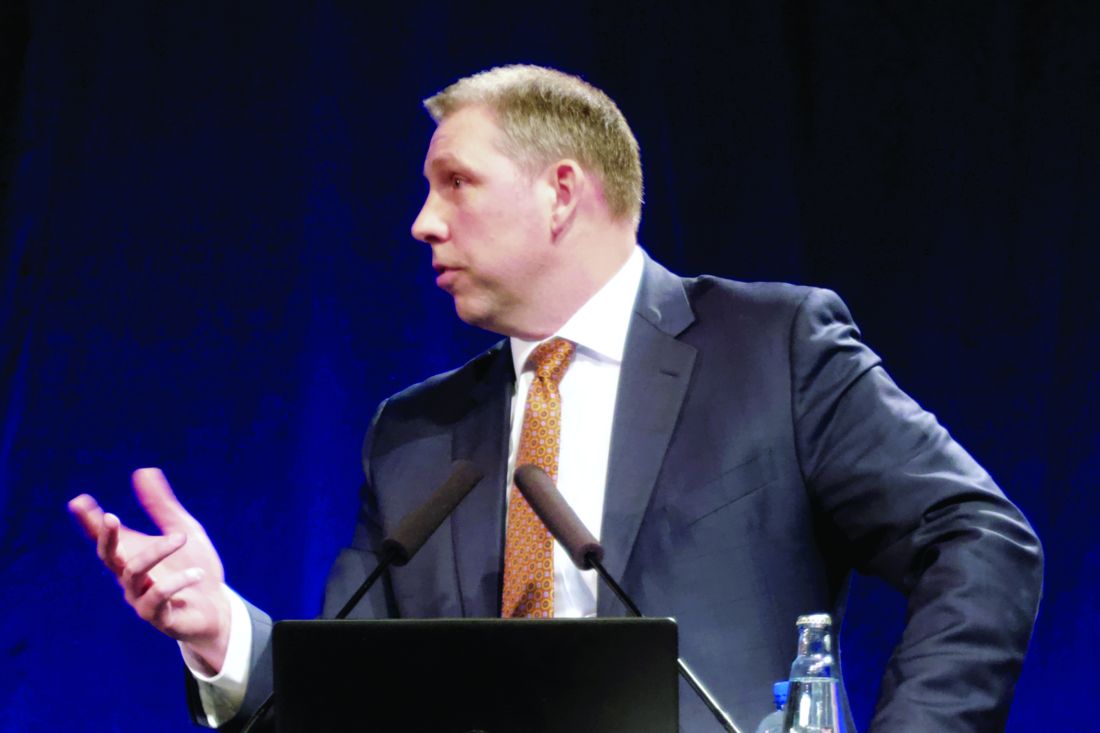User login
Gene therapy in hemophilia is just version 1.0
PRAGUE – Adeno-associated virus (AAV)–based gene therapy is probably not the “endgame” in gene therapy for hemophilia, according to John Pasi, MD, PhD, director of the Haemophilia Centre at the Royal London Hospital.
“Gene therapy today is essentially gene therapy version 1.0,” Dr. Pasi said, kicking off the third day at the annual congress of the European Association for Haemophilia and Allied Disorders.
Interwoven with a summary of recent research and upcoming trends, Dr. Pasi reflected upon the medical community’s expectations for gene therapy, both past and present.
“For years,” Dr. Pasi said, “gene therapy has been regarded, essentially, as the Holy Grail of treatment for hemophilia.” This sentiment has been supported by the fact that hemophilia “is a single-gene disorder with a cause and effect relationship that is extremely clear and straightforward for us to recognize.”
A small increase in clotting factor can significantly reduce bleeding while providing a measurable efficacy outcome, making it a strong research candidate.
Looking back, however, when gene therapy research began in the early 1990s, it “really did go through a peak of inflated expectations,” Dr. Pasi said. “We thought for years it was just around the corner. But there were abject failures; there were learning curves we had to go through to understand many of the issues that gene therapy threw up, which we didn’t understand at the beginning.”
When this early excitement was met with tough realities, a period of disillusionment began and persisted through the early 2000s. Dr. Pasi suggested that this period of disillusionment may be reaching an end because of a “huge amount of steady work” that has ushered in a new period of productivity.
Dr. Pasi cited two 2017 studies published in the New England Journal of Medicine by Savita Rangarajan, MBBS, and colleagues and Lindsey A. George, MD, and colleagues for hemophilia A and B, respectively (N Engl J Med. 2017; 377:2519-30; N Engl J Med. 2017; 377:2215-27).
In contrast with previous studies showing factor levels in the single digits, recent studies have achieved normal-range values. Seeing such improvements in hemophilia A, is a particular source of optimism; historically, gene therapy for hemophilia A has lagged behind hemophilia B because of a larger gene that is more difficult to work with.
“This has stepped up the game hugely,” Dr. Pasi said.
The elements of gene therapy for hemophilia may change over time. For instance, lentiviruses could be used instead of AAV-based methods, and ex vivo techniques could make a comeback, potentially using different tissue sources. These changes are likely on the distant horizon, however.
Gene modification is also not coming anytime soon.
“Gene replacement, gene editing, and gene repair are something that we hear a lot about in the general field of gene therapy,” Dr. Pasi said, “But in practical terms for our patients, we probably are a significant way off from this at the moment, and this is because we know and we all recognize that there are a wide range of mutations causing hemophilia, and many of these are highly specific; we will need specific gene therapies to address specific mutations.”
Dr. Pasi likened the current state of gene therapy to that of the self-driving car, suggesting that “we still have strides to make, and there are still things we can improve on beyond what we have today.
“The biggest question for gene therapy today is durability,” Dr. Pasi said. “How long are these things going to last?”
Patients from earlier studies are now crossing the half-decade mark, albeit with relatively low factor levels, compared with recent techniques. One such study, presented at the 2018 annual meeting of the American Society of Hematology by Amit C. Nathwani, MD, PhD, and colleagues, is “very critical to our understanding,” Dr. Pasi said, referring to patients who are now 6-8 years post treatment. “What we see is … continued, stable expression of factor IX,” he said.
Alongside questions of durability, safety remains paramount in the quest for better methods of gene therapy.
“We are seeing liver function abnormalities,” Dr. Pasi said, noting that these tend to be transient elevations of ALT. “We know that many patients now have to receive steroid treatment, which very effectively reduces the immune response, but it is something that we are increasingly having to bear in mind.”
The latest techniques are using liver-specific promoters in novel synthetic capsids, and more capsids are under development.
Dr. Pasi also emphasized safety and caution. “We must never forget that gene therapy is a completely new approach to treatment, and we’ve got to think about safety. It is the number one priority when we are investigating new treatments.”
Safety remains untested in several key patient subpopulations, including children and those with comorbidities or inhibitors.
“For gene therapy in 2019,” he said, “we’ve made massive strides, but we’re not quite there yet.”
PRAGUE – Adeno-associated virus (AAV)–based gene therapy is probably not the “endgame” in gene therapy for hemophilia, according to John Pasi, MD, PhD, director of the Haemophilia Centre at the Royal London Hospital.
“Gene therapy today is essentially gene therapy version 1.0,” Dr. Pasi said, kicking off the third day at the annual congress of the European Association for Haemophilia and Allied Disorders.
Interwoven with a summary of recent research and upcoming trends, Dr. Pasi reflected upon the medical community’s expectations for gene therapy, both past and present.
“For years,” Dr. Pasi said, “gene therapy has been regarded, essentially, as the Holy Grail of treatment for hemophilia.” This sentiment has been supported by the fact that hemophilia “is a single-gene disorder with a cause and effect relationship that is extremely clear and straightforward for us to recognize.”
A small increase in clotting factor can significantly reduce bleeding while providing a measurable efficacy outcome, making it a strong research candidate.
Looking back, however, when gene therapy research began in the early 1990s, it “really did go through a peak of inflated expectations,” Dr. Pasi said. “We thought for years it was just around the corner. But there were abject failures; there were learning curves we had to go through to understand many of the issues that gene therapy threw up, which we didn’t understand at the beginning.”
When this early excitement was met with tough realities, a period of disillusionment began and persisted through the early 2000s. Dr. Pasi suggested that this period of disillusionment may be reaching an end because of a “huge amount of steady work” that has ushered in a new period of productivity.
Dr. Pasi cited two 2017 studies published in the New England Journal of Medicine by Savita Rangarajan, MBBS, and colleagues and Lindsey A. George, MD, and colleagues for hemophilia A and B, respectively (N Engl J Med. 2017; 377:2519-30; N Engl J Med. 2017; 377:2215-27).
In contrast with previous studies showing factor levels in the single digits, recent studies have achieved normal-range values. Seeing such improvements in hemophilia A, is a particular source of optimism; historically, gene therapy for hemophilia A has lagged behind hemophilia B because of a larger gene that is more difficult to work with.
“This has stepped up the game hugely,” Dr. Pasi said.
The elements of gene therapy for hemophilia may change over time. For instance, lentiviruses could be used instead of AAV-based methods, and ex vivo techniques could make a comeback, potentially using different tissue sources. These changes are likely on the distant horizon, however.
Gene modification is also not coming anytime soon.
“Gene replacement, gene editing, and gene repair are something that we hear a lot about in the general field of gene therapy,” Dr. Pasi said, “But in practical terms for our patients, we probably are a significant way off from this at the moment, and this is because we know and we all recognize that there are a wide range of mutations causing hemophilia, and many of these are highly specific; we will need specific gene therapies to address specific mutations.”
Dr. Pasi likened the current state of gene therapy to that of the self-driving car, suggesting that “we still have strides to make, and there are still things we can improve on beyond what we have today.
“The biggest question for gene therapy today is durability,” Dr. Pasi said. “How long are these things going to last?”
Patients from earlier studies are now crossing the half-decade mark, albeit with relatively low factor levels, compared with recent techniques. One such study, presented at the 2018 annual meeting of the American Society of Hematology by Amit C. Nathwani, MD, PhD, and colleagues, is “very critical to our understanding,” Dr. Pasi said, referring to patients who are now 6-8 years post treatment. “What we see is … continued, stable expression of factor IX,” he said.
Alongside questions of durability, safety remains paramount in the quest for better methods of gene therapy.
“We are seeing liver function abnormalities,” Dr. Pasi said, noting that these tend to be transient elevations of ALT. “We know that many patients now have to receive steroid treatment, which very effectively reduces the immune response, but it is something that we are increasingly having to bear in mind.”
The latest techniques are using liver-specific promoters in novel synthetic capsids, and more capsids are under development.
Dr. Pasi also emphasized safety and caution. “We must never forget that gene therapy is a completely new approach to treatment, and we’ve got to think about safety. It is the number one priority when we are investigating new treatments.”
Safety remains untested in several key patient subpopulations, including children and those with comorbidities or inhibitors.
“For gene therapy in 2019,” he said, “we’ve made massive strides, but we’re not quite there yet.”
PRAGUE – Adeno-associated virus (AAV)–based gene therapy is probably not the “endgame” in gene therapy for hemophilia, according to John Pasi, MD, PhD, director of the Haemophilia Centre at the Royal London Hospital.
“Gene therapy today is essentially gene therapy version 1.0,” Dr. Pasi said, kicking off the third day at the annual congress of the European Association for Haemophilia and Allied Disorders.
Interwoven with a summary of recent research and upcoming trends, Dr. Pasi reflected upon the medical community’s expectations for gene therapy, both past and present.
“For years,” Dr. Pasi said, “gene therapy has been regarded, essentially, as the Holy Grail of treatment for hemophilia.” This sentiment has been supported by the fact that hemophilia “is a single-gene disorder with a cause and effect relationship that is extremely clear and straightforward for us to recognize.”
A small increase in clotting factor can significantly reduce bleeding while providing a measurable efficacy outcome, making it a strong research candidate.
Looking back, however, when gene therapy research began in the early 1990s, it “really did go through a peak of inflated expectations,” Dr. Pasi said. “We thought for years it was just around the corner. But there were abject failures; there were learning curves we had to go through to understand many of the issues that gene therapy threw up, which we didn’t understand at the beginning.”
When this early excitement was met with tough realities, a period of disillusionment began and persisted through the early 2000s. Dr. Pasi suggested that this period of disillusionment may be reaching an end because of a “huge amount of steady work” that has ushered in a new period of productivity.
Dr. Pasi cited two 2017 studies published in the New England Journal of Medicine by Savita Rangarajan, MBBS, and colleagues and Lindsey A. George, MD, and colleagues for hemophilia A and B, respectively (N Engl J Med. 2017; 377:2519-30; N Engl J Med. 2017; 377:2215-27).
In contrast with previous studies showing factor levels in the single digits, recent studies have achieved normal-range values. Seeing such improvements in hemophilia A, is a particular source of optimism; historically, gene therapy for hemophilia A has lagged behind hemophilia B because of a larger gene that is more difficult to work with.
“This has stepped up the game hugely,” Dr. Pasi said.
The elements of gene therapy for hemophilia may change over time. For instance, lentiviruses could be used instead of AAV-based methods, and ex vivo techniques could make a comeback, potentially using different tissue sources. These changes are likely on the distant horizon, however.
Gene modification is also not coming anytime soon.
“Gene replacement, gene editing, and gene repair are something that we hear a lot about in the general field of gene therapy,” Dr. Pasi said, “But in practical terms for our patients, we probably are a significant way off from this at the moment, and this is because we know and we all recognize that there are a wide range of mutations causing hemophilia, and many of these are highly specific; we will need specific gene therapies to address specific mutations.”
Dr. Pasi likened the current state of gene therapy to that of the self-driving car, suggesting that “we still have strides to make, and there are still things we can improve on beyond what we have today.
“The biggest question for gene therapy today is durability,” Dr. Pasi said. “How long are these things going to last?”
Patients from earlier studies are now crossing the half-decade mark, albeit with relatively low factor levels, compared with recent techniques. One such study, presented at the 2018 annual meeting of the American Society of Hematology by Amit C. Nathwani, MD, PhD, and colleagues, is “very critical to our understanding,” Dr. Pasi said, referring to patients who are now 6-8 years post treatment. “What we see is … continued, stable expression of factor IX,” he said.
Alongside questions of durability, safety remains paramount in the quest for better methods of gene therapy.
“We are seeing liver function abnormalities,” Dr. Pasi said, noting that these tend to be transient elevations of ALT. “We know that many patients now have to receive steroid treatment, which very effectively reduces the immune response, but it is something that we are increasingly having to bear in mind.”
The latest techniques are using liver-specific promoters in novel synthetic capsids, and more capsids are under development.
Dr. Pasi also emphasized safety and caution. “We must never forget that gene therapy is a completely new approach to treatment, and we’ve got to think about safety. It is the number one priority when we are investigating new treatments.”
Safety remains untested in several key patient subpopulations, including children and those with comorbidities or inhibitors.
“For gene therapy in 2019,” he said, “we’ve made massive strides, but we’re not quite there yet.”
EXPERT ANALYSIS FROM EAHAD 2019
Think duration, not dose, when managing bleeding with non–factor replacements
PRAGUE – Clinicians should prioritize treatment duration with factors or bypassing agents – not dose level – when managing breakthrough bleeds in patients with hemophilia who are on non–factor replacement therapy, according to a leading expert.
Duration of treatment is more strongly associated with thromboembolism than dose magnitude, said Andreas Tiede, MD, PhD, head of hemostaseology at Hannover (Germany) Medical School in Germany, noting that recommendations vary by non–factor replacement agent.
These remarks were part of a presentation about novel agents for treatment of hemophilia with inhibitors delivered at the annual congress of the European Association for Haemophilia and Allied Disorders.
“Concomitant use of factor products, both factor VIII and IX, and the bypassing agents, have usually preceded thromboembolic events in clinical trials [for non–factor replacement therapies] so this [topic] is crucial,” Dr. Tiede said.
Other experts recommend lower doses and shorter treatment durations. “I think that’s reasonable, but with some question mark behind the low doses,” he said. “I think it depends a little bit on the interaction between the non–factor replacement therapy and the bypassing agent in your patient.”
With a busy pipeline of non–factor replacement agents for hemophilia, such interactions are becoming increasingly relevant for clinicians and their patients.
Emicizumab, for instance, which is now approved for hemophilia with or without inhibitors, has synergistic activity with activated prothrombin complex concentrates (APCC). This was demonstrated by an emicizumab prophylaxis trial in which five out of eight patients with breakthrough bleeding who were treated with APPC at a dose higher than 100 IU/kg per day for more than 24 hours developed thrombotic microangiopathy. (N Engl J Med. 2017;377:809-18).
Other patients who received multiple infusions of APCC developed skin necrosis, cavernous vein thrombosis, and thrombophlebitis. Consequently, it is now recommended that APCC be avoided in patients taking emicizumab, and if unavoidable, given at the lowest dose possible. However, Dr. Tiede advised that this recommendation for APCC should not be extrapolated to encompass all factors and bypassing agents, based on existing data.
“Regarding higher or lower doses for initial treatment, I would be a little bit more careful,” he said. “That obviously depends on [whether] there is a synergistic effect with the non–factor replacement therapy and the bypassing agent. Synergistic effects have clearly been shown for the interaction of emicizumab and APCC, but when it comes to the interaction between emicizumab and VIIa, I’m not so sure. I don’t think that we have enough evidence to recommend lower doses of VIIa.”
Dr. Tiede also suggested that lower doses of factor VIII are probably unnecessary. “At high doses or high concentrations of factor VIII, emicizumab’s low affinity to the targets will not result in any significant action anymore,” he said. “So I think we have to wait for more data from basic research and also more clinical data.”
Regarding concern for duration of therapy, Dr. Tiede explained that, when treating breakthrough bleeding in a patient on non–factor replacement therapy, “the patient’s hemostatic protection level will never fall to zero, as it would have done in a patient treated previously, on demand with bypassing agents only.” Since hemostatic protection levels never return to zero, it is easier to enter the thromboembolic danger zone.
This risk was recently demonstrated by an emerging non-factor replacement therapy. In a phase 3 trial for fitusiran – a small interfering RNA therapy that targets antithrombin – a patient with hemophilia A developed a breakthrough bleed and 31-46 IU/kg of factor VIII was given, resulting in fatal cerebral sinus thrombosis. After a temporary hold, the study restarted with new limits on factor and bypassing agent doses.
Dr. Tiede reported financial relationships with Bayer, Biotest, CSL Behring, Novo Nordisk, Pfizer, and other companies.
PRAGUE – Clinicians should prioritize treatment duration with factors or bypassing agents – not dose level – when managing breakthrough bleeds in patients with hemophilia who are on non–factor replacement therapy, according to a leading expert.
Duration of treatment is more strongly associated with thromboembolism than dose magnitude, said Andreas Tiede, MD, PhD, head of hemostaseology at Hannover (Germany) Medical School in Germany, noting that recommendations vary by non–factor replacement agent.
These remarks were part of a presentation about novel agents for treatment of hemophilia with inhibitors delivered at the annual congress of the European Association for Haemophilia and Allied Disorders.
“Concomitant use of factor products, both factor VIII and IX, and the bypassing agents, have usually preceded thromboembolic events in clinical trials [for non–factor replacement therapies] so this [topic] is crucial,” Dr. Tiede said.
Other experts recommend lower doses and shorter treatment durations. “I think that’s reasonable, but with some question mark behind the low doses,” he said. “I think it depends a little bit on the interaction between the non–factor replacement therapy and the bypassing agent in your patient.”
With a busy pipeline of non–factor replacement agents for hemophilia, such interactions are becoming increasingly relevant for clinicians and their patients.
Emicizumab, for instance, which is now approved for hemophilia with or without inhibitors, has synergistic activity with activated prothrombin complex concentrates (APCC). This was demonstrated by an emicizumab prophylaxis trial in which five out of eight patients with breakthrough bleeding who were treated with APPC at a dose higher than 100 IU/kg per day for more than 24 hours developed thrombotic microangiopathy. (N Engl J Med. 2017;377:809-18).
Other patients who received multiple infusions of APCC developed skin necrosis, cavernous vein thrombosis, and thrombophlebitis. Consequently, it is now recommended that APCC be avoided in patients taking emicizumab, and if unavoidable, given at the lowest dose possible. However, Dr. Tiede advised that this recommendation for APCC should not be extrapolated to encompass all factors and bypassing agents, based on existing data.
“Regarding higher or lower doses for initial treatment, I would be a little bit more careful,” he said. “That obviously depends on [whether] there is a synergistic effect with the non–factor replacement therapy and the bypassing agent. Synergistic effects have clearly been shown for the interaction of emicizumab and APCC, but when it comes to the interaction between emicizumab and VIIa, I’m not so sure. I don’t think that we have enough evidence to recommend lower doses of VIIa.”
Dr. Tiede also suggested that lower doses of factor VIII are probably unnecessary. “At high doses or high concentrations of factor VIII, emicizumab’s low affinity to the targets will not result in any significant action anymore,” he said. “So I think we have to wait for more data from basic research and also more clinical data.”
Regarding concern for duration of therapy, Dr. Tiede explained that, when treating breakthrough bleeding in a patient on non–factor replacement therapy, “the patient’s hemostatic protection level will never fall to zero, as it would have done in a patient treated previously, on demand with bypassing agents only.” Since hemostatic protection levels never return to zero, it is easier to enter the thromboembolic danger zone.
This risk was recently demonstrated by an emerging non-factor replacement therapy. In a phase 3 trial for fitusiran – a small interfering RNA therapy that targets antithrombin – a patient with hemophilia A developed a breakthrough bleed and 31-46 IU/kg of factor VIII was given, resulting in fatal cerebral sinus thrombosis. After a temporary hold, the study restarted with new limits on factor and bypassing agent doses.
Dr. Tiede reported financial relationships with Bayer, Biotest, CSL Behring, Novo Nordisk, Pfizer, and other companies.
PRAGUE – Clinicians should prioritize treatment duration with factors or bypassing agents – not dose level – when managing breakthrough bleeds in patients with hemophilia who are on non–factor replacement therapy, according to a leading expert.
Duration of treatment is more strongly associated with thromboembolism than dose magnitude, said Andreas Tiede, MD, PhD, head of hemostaseology at Hannover (Germany) Medical School in Germany, noting that recommendations vary by non–factor replacement agent.
These remarks were part of a presentation about novel agents for treatment of hemophilia with inhibitors delivered at the annual congress of the European Association for Haemophilia and Allied Disorders.
“Concomitant use of factor products, both factor VIII and IX, and the bypassing agents, have usually preceded thromboembolic events in clinical trials [for non–factor replacement therapies] so this [topic] is crucial,” Dr. Tiede said.
Other experts recommend lower doses and shorter treatment durations. “I think that’s reasonable, but with some question mark behind the low doses,” he said. “I think it depends a little bit on the interaction between the non–factor replacement therapy and the bypassing agent in your patient.”
With a busy pipeline of non–factor replacement agents for hemophilia, such interactions are becoming increasingly relevant for clinicians and their patients.
Emicizumab, for instance, which is now approved for hemophilia with or without inhibitors, has synergistic activity with activated prothrombin complex concentrates (APCC). This was demonstrated by an emicizumab prophylaxis trial in which five out of eight patients with breakthrough bleeding who were treated with APPC at a dose higher than 100 IU/kg per day for more than 24 hours developed thrombotic microangiopathy. (N Engl J Med. 2017;377:809-18).
Other patients who received multiple infusions of APCC developed skin necrosis, cavernous vein thrombosis, and thrombophlebitis. Consequently, it is now recommended that APCC be avoided in patients taking emicizumab, and if unavoidable, given at the lowest dose possible. However, Dr. Tiede advised that this recommendation for APCC should not be extrapolated to encompass all factors and bypassing agents, based on existing data.
“Regarding higher or lower doses for initial treatment, I would be a little bit more careful,” he said. “That obviously depends on [whether] there is a synergistic effect with the non–factor replacement therapy and the bypassing agent. Synergistic effects have clearly been shown for the interaction of emicizumab and APCC, but when it comes to the interaction between emicizumab and VIIa, I’m not so sure. I don’t think that we have enough evidence to recommend lower doses of VIIa.”
Dr. Tiede also suggested that lower doses of factor VIII are probably unnecessary. “At high doses or high concentrations of factor VIII, emicizumab’s low affinity to the targets will not result in any significant action anymore,” he said. “So I think we have to wait for more data from basic research and also more clinical data.”
Regarding concern for duration of therapy, Dr. Tiede explained that, when treating breakthrough bleeding in a patient on non–factor replacement therapy, “the patient’s hemostatic protection level will never fall to zero, as it would have done in a patient treated previously, on demand with bypassing agents only.” Since hemostatic protection levels never return to zero, it is easier to enter the thromboembolic danger zone.
This risk was recently demonstrated by an emerging non-factor replacement therapy. In a phase 3 trial for fitusiran – a small interfering RNA therapy that targets antithrombin – a patient with hemophilia A developed a breakthrough bleed and 31-46 IU/kg of factor VIII was given, resulting in fatal cerebral sinus thrombosis. After a temporary hold, the study restarted with new limits on factor and bypassing agent doses.
Dr. Tiede reported financial relationships with Bayer, Biotest, CSL Behring, Novo Nordisk, Pfizer, and other companies.
EXPERT ANALYSIS FROM EAHAD 2019
Emicizumab performs well in surgical setting
PRAGUE – Emicizumab appears safe and effective for patients with hemophilia A undergoing surgical procedures, based on experience with a subpopulation of HAVEN 3 trial participants.
Out of 28 minor procedures performed without preventive factor VIII (FVIII), only 2 were associated with postoperative bleeds requiring treatment, reported lead author Elena Santagostino, MD, PhD, of Fondazione IRCCS Ca’ Granda Ospedale Maggiore Policlinico in Milan, and her colleagues.
All events requiring bleeding treatment were associated with dental procedures, highlighting an area where clinicians and dentists may need to exercise caution. Still, overall results supported emicizumab in a surgical setting.
“There were no thrombotic complications or other unexpected events, including inhibitor development,” Dr. Santagostino said at the annual congress of the European Association for Haemophilia and Allied Disorders.
The findings were drawn from 30 patients who underwent 50 surgeries (46 minor, 4 major) during HAVEN 3, a previously reported phase 3 trial investigating the use of emicizumab, a humanized bispecific monoclonal antibody for patients with hemophilia A without inhibitors.
The minor surgeries included dental or orthopedic procedures, esophagogastroduodenoscopy, or colonoscopy. The four major procedures were all orthopedic (knee arthroscopic synovectomy, biceps femoris tear repair, total ankle arthroplasty, and total hip replacement). The investigators analyzed surgery-related bleeds and the nature of FVIII usage.
Preventive FVIII was used in 18 procedures; infusion duration was 24 hours or less in 14 procedures, between 25 hours and 48 hours in 2 procedures, and more than 72 hours in 2 procedures. The median cumulative preventive FVIII dose per procedure was 30 IU/kg.
Of the 46 minor procedures, 28 (61%) were performed without preventive FVIII, and 2 (7.1%) were associated with bleeding requiring treatment, both after dental procedures. Two other participants who received preventive FVIII also needed postoperative bleeding treatment. Of note, these events were also after dental procedures, meaning all four instances of bleeding requiring treatment during the trial were associated with dentistry.
“[I]n this experience, dental procedures were somewhat tricky because the bleeding complications were mainly there,” Dr. Santagostino said.
When asked by an audience member if this trend was unique to mucosal bleeding, Dr. Santagostino said it was too early to draw such a conclusion but offered some insight. “To control and prevent bleeding during a dental procedure is not trivial, because … sometimes if you stop factor VIII treatment quite early, you may have late bleeding, mainly due to local reasons, because … dental procedures are very heterogenous.”
Among three other participants who had postoperative bleeding but did not require treatment, two underwent dental procedures, further supporting this association. Although the study numbers are relatively small, the findings may at least support caution, if not preventive FVIII in the dental setting, Dr. Santagostino said.
The four major procedures – all orthopedic – were knee arthroscopic synovectomy, biceps femoris tear repair, total ankle arthroplasty, and total hip replacement. Along with preoperative preventive FVIII, three of four patients undergoing major surgery received preventive FVIII for 14-18 days postoperatively. Doses ranged from 99-522 IU/kg. No postoperative bleeds occurred in this subgroup.
Study funding was provided by F. Hoffmann–La Roche and Chugai Pharmaceutical. The investigators reported financial relationships with Bayer, Shire, Pfizer, Novo Nordisk, and others.
SOURCE: Santagostino E et al. EAHAD 2019, Abstract OR15.
PRAGUE – Emicizumab appears safe and effective for patients with hemophilia A undergoing surgical procedures, based on experience with a subpopulation of HAVEN 3 trial participants.
Out of 28 minor procedures performed without preventive factor VIII (FVIII), only 2 were associated with postoperative bleeds requiring treatment, reported lead author Elena Santagostino, MD, PhD, of Fondazione IRCCS Ca’ Granda Ospedale Maggiore Policlinico in Milan, and her colleagues.
All events requiring bleeding treatment were associated with dental procedures, highlighting an area where clinicians and dentists may need to exercise caution. Still, overall results supported emicizumab in a surgical setting.
“There were no thrombotic complications or other unexpected events, including inhibitor development,” Dr. Santagostino said at the annual congress of the European Association for Haemophilia and Allied Disorders.
The findings were drawn from 30 patients who underwent 50 surgeries (46 minor, 4 major) during HAVEN 3, a previously reported phase 3 trial investigating the use of emicizumab, a humanized bispecific monoclonal antibody for patients with hemophilia A without inhibitors.
The minor surgeries included dental or orthopedic procedures, esophagogastroduodenoscopy, or colonoscopy. The four major procedures were all orthopedic (knee arthroscopic synovectomy, biceps femoris tear repair, total ankle arthroplasty, and total hip replacement). The investigators analyzed surgery-related bleeds and the nature of FVIII usage.
Preventive FVIII was used in 18 procedures; infusion duration was 24 hours or less in 14 procedures, between 25 hours and 48 hours in 2 procedures, and more than 72 hours in 2 procedures. The median cumulative preventive FVIII dose per procedure was 30 IU/kg.
Of the 46 minor procedures, 28 (61%) were performed without preventive FVIII, and 2 (7.1%) were associated with bleeding requiring treatment, both after dental procedures. Two other participants who received preventive FVIII also needed postoperative bleeding treatment. Of note, these events were also after dental procedures, meaning all four instances of bleeding requiring treatment during the trial were associated with dentistry.
“[I]n this experience, dental procedures were somewhat tricky because the bleeding complications were mainly there,” Dr. Santagostino said.
When asked by an audience member if this trend was unique to mucosal bleeding, Dr. Santagostino said it was too early to draw such a conclusion but offered some insight. “To control and prevent bleeding during a dental procedure is not trivial, because … sometimes if you stop factor VIII treatment quite early, you may have late bleeding, mainly due to local reasons, because … dental procedures are very heterogenous.”
Among three other participants who had postoperative bleeding but did not require treatment, two underwent dental procedures, further supporting this association. Although the study numbers are relatively small, the findings may at least support caution, if not preventive FVIII in the dental setting, Dr. Santagostino said.
The four major procedures – all orthopedic – were knee arthroscopic synovectomy, biceps femoris tear repair, total ankle arthroplasty, and total hip replacement. Along with preoperative preventive FVIII, three of four patients undergoing major surgery received preventive FVIII for 14-18 days postoperatively. Doses ranged from 99-522 IU/kg. No postoperative bleeds occurred in this subgroup.
Study funding was provided by F. Hoffmann–La Roche and Chugai Pharmaceutical. The investigators reported financial relationships with Bayer, Shire, Pfizer, Novo Nordisk, and others.
SOURCE: Santagostino E et al. EAHAD 2019, Abstract OR15.
PRAGUE – Emicizumab appears safe and effective for patients with hemophilia A undergoing surgical procedures, based on experience with a subpopulation of HAVEN 3 trial participants.
Out of 28 minor procedures performed without preventive factor VIII (FVIII), only 2 were associated with postoperative bleeds requiring treatment, reported lead author Elena Santagostino, MD, PhD, of Fondazione IRCCS Ca’ Granda Ospedale Maggiore Policlinico in Milan, and her colleagues.
All events requiring bleeding treatment were associated with dental procedures, highlighting an area where clinicians and dentists may need to exercise caution. Still, overall results supported emicizumab in a surgical setting.
“There were no thrombotic complications or other unexpected events, including inhibitor development,” Dr. Santagostino said at the annual congress of the European Association for Haemophilia and Allied Disorders.
The findings were drawn from 30 patients who underwent 50 surgeries (46 minor, 4 major) during HAVEN 3, a previously reported phase 3 trial investigating the use of emicizumab, a humanized bispecific monoclonal antibody for patients with hemophilia A without inhibitors.
The minor surgeries included dental or orthopedic procedures, esophagogastroduodenoscopy, or colonoscopy. The four major procedures were all orthopedic (knee arthroscopic synovectomy, biceps femoris tear repair, total ankle arthroplasty, and total hip replacement). The investigators analyzed surgery-related bleeds and the nature of FVIII usage.
Preventive FVIII was used in 18 procedures; infusion duration was 24 hours or less in 14 procedures, between 25 hours and 48 hours in 2 procedures, and more than 72 hours in 2 procedures. The median cumulative preventive FVIII dose per procedure was 30 IU/kg.
Of the 46 minor procedures, 28 (61%) were performed without preventive FVIII, and 2 (7.1%) were associated with bleeding requiring treatment, both after dental procedures. Two other participants who received preventive FVIII also needed postoperative bleeding treatment. Of note, these events were also after dental procedures, meaning all four instances of bleeding requiring treatment during the trial were associated with dentistry.
“[I]n this experience, dental procedures were somewhat tricky because the bleeding complications were mainly there,” Dr. Santagostino said.
When asked by an audience member if this trend was unique to mucosal bleeding, Dr. Santagostino said it was too early to draw such a conclusion but offered some insight. “To control and prevent bleeding during a dental procedure is not trivial, because … sometimes if you stop factor VIII treatment quite early, you may have late bleeding, mainly due to local reasons, because … dental procedures are very heterogenous.”
Among three other participants who had postoperative bleeding but did not require treatment, two underwent dental procedures, further supporting this association. Although the study numbers are relatively small, the findings may at least support caution, if not preventive FVIII in the dental setting, Dr. Santagostino said.
The four major procedures – all orthopedic – were knee arthroscopic synovectomy, biceps femoris tear repair, total ankle arthroplasty, and total hip replacement. Along with preoperative preventive FVIII, three of four patients undergoing major surgery received preventive FVIII for 14-18 days postoperatively. Doses ranged from 99-522 IU/kg. No postoperative bleeds occurred in this subgroup.
Study funding was provided by F. Hoffmann–La Roche and Chugai Pharmaceutical. The investigators reported financial relationships with Bayer, Shire, Pfizer, Novo Nordisk, and others.
SOURCE: Santagostino E et al. EAHAD 2019, Abstract OR15.
REPORTING FROM EAHAD 2019
Subcutaneous FVIIa marzeptacog alfa reduced bleeding days
PRAGUE – Patients with hemophilia A or B and inhibitors may have reduced bleeding days when given subcutaneous factor VIIa (FVIIa) marzeptacog alfa, according to early results from a phase 2/3 trial.
The ongoing study is evaluating pharmacokinetics, pharmacodynamics, efficacy, and safety of marzeptacog alfa, which has four engineered amino acid substitutions within the FVIIa protein to increase catalytic activity, reported lead author Howard Levy, MBBCh, PhD, chief medical officer of Catalyst Biosciences in San Francisco, and his colleagues.
“[Marzeptacog alfa] is about nine times as potent as NovoSeven [RT],” Dr. Levy said, referring to the FVIIa product from Novo Nordisk. “This allows for subcutaneous dosing. One of the advantages of subcutaneous dosing is that it further prolongs the half-life.”
Dr. Levy presented the findings at the annual congress of the European Association for Haemophilia and Allied Disorders.
The study involved 12 patients with hemophilia A or B and inhibitors, all of whom began with an annualized bleeding rate (ABR) of more than 12 days per year; of these, 7 have completed dosing.
Following pharmacokinetic analysis, subcutaneous dosing began at an initial dose of 30 mcg/kg daily. As-needed dose escalations were allowed at regular intervals. Specifically, if spontaneous bleeding occurred, then at the next 50-day interval, an individual patient’s dose would be increased to the next level. Dose levels were 30 mcg/kg, 60 mcg/kg, 90 mcg/kg, and 120 mcg/kg.
Any patient completing a 50-day interval without bleeding was finished with the study and proceeded to a 30-day follow-up period, during which time resumption of bleeding was monitored. The primary endpoint was a reduction in the ABR at the final dose level. Secondary endpoints were safety, tolerability, and a lack of inhibitor formation.
As Dr. Levy discussed results, he expressed concern that ABR is an inadequate measure of efficacy. “There is a significant amount hidden by the raw statistic of an annualized bleed rate.” He elaborated further by describing two trial participants who each had an ABR of about 23 days per year but had very different proportions of days with bleeding in the 6-month lead-in period (22% vs. 9%), suggesting that this proportion may provide a clearer impression of efficacy.
Prior to treatment, the mean ABR among all patients was 19 days per year and the median proportion of days with bleeding was 11%. This latter value dropped from 11% to 1% with treatment. The former value, ABR, was reduced in a “clinically significant” fashion, although exact values were not provided (P = .009).
Two patients required dose escalation to 60 mcg/kg, and five out of seven patients had no bleeding (traumatic or spontaneous), at their final dose levels.
Subcutaneous half-life was 13.1 hours, compared with intravenous half-life of 3.9 hours. After more than 260 cumulative days of subcutaneous injections, no thromboses or antidrug antibodies were detected. Two subjects had a total of six injection site reactions, with mild to moderate redness and moderate swelling that resolved without sequelae.
One patient died on day 11 of the trial because of fatal hemorrhagic stroke, but this patient had uncontrolled hypertension and the death was not considered drug related.
More clinical data from this trial will be reported in July 2019 at the annual congress of the International Society on Thrombosis and Haemostasis in Melbourne.
The study was funded by Catalyst Biosciences. Dr. Levy and multiple coauthors are employees, shareholders, or consultants for Catalyst Biosciences.
SOURCE: Levy H et al. EAHAD 2019, Abstract OR11.
PRAGUE – Patients with hemophilia A or B and inhibitors may have reduced bleeding days when given subcutaneous factor VIIa (FVIIa) marzeptacog alfa, according to early results from a phase 2/3 trial.
The ongoing study is evaluating pharmacokinetics, pharmacodynamics, efficacy, and safety of marzeptacog alfa, which has four engineered amino acid substitutions within the FVIIa protein to increase catalytic activity, reported lead author Howard Levy, MBBCh, PhD, chief medical officer of Catalyst Biosciences in San Francisco, and his colleagues.
“[Marzeptacog alfa] is about nine times as potent as NovoSeven [RT],” Dr. Levy said, referring to the FVIIa product from Novo Nordisk. “This allows for subcutaneous dosing. One of the advantages of subcutaneous dosing is that it further prolongs the half-life.”
Dr. Levy presented the findings at the annual congress of the European Association for Haemophilia and Allied Disorders.
The study involved 12 patients with hemophilia A or B and inhibitors, all of whom began with an annualized bleeding rate (ABR) of more than 12 days per year; of these, 7 have completed dosing.
Following pharmacokinetic analysis, subcutaneous dosing began at an initial dose of 30 mcg/kg daily. As-needed dose escalations were allowed at regular intervals. Specifically, if spontaneous bleeding occurred, then at the next 50-day interval, an individual patient’s dose would be increased to the next level. Dose levels were 30 mcg/kg, 60 mcg/kg, 90 mcg/kg, and 120 mcg/kg.
Any patient completing a 50-day interval without bleeding was finished with the study and proceeded to a 30-day follow-up period, during which time resumption of bleeding was monitored. The primary endpoint was a reduction in the ABR at the final dose level. Secondary endpoints were safety, tolerability, and a lack of inhibitor formation.
As Dr. Levy discussed results, he expressed concern that ABR is an inadequate measure of efficacy. “There is a significant amount hidden by the raw statistic of an annualized bleed rate.” He elaborated further by describing two trial participants who each had an ABR of about 23 days per year but had very different proportions of days with bleeding in the 6-month lead-in period (22% vs. 9%), suggesting that this proportion may provide a clearer impression of efficacy.
Prior to treatment, the mean ABR among all patients was 19 days per year and the median proportion of days with bleeding was 11%. This latter value dropped from 11% to 1% with treatment. The former value, ABR, was reduced in a “clinically significant” fashion, although exact values were not provided (P = .009).
Two patients required dose escalation to 60 mcg/kg, and five out of seven patients had no bleeding (traumatic or spontaneous), at their final dose levels.
Subcutaneous half-life was 13.1 hours, compared with intravenous half-life of 3.9 hours. After more than 260 cumulative days of subcutaneous injections, no thromboses or antidrug antibodies were detected. Two subjects had a total of six injection site reactions, with mild to moderate redness and moderate swelling that resolved without sequelae.
One patient died on day 11 of the trial because of fatal hemorrhagic stroke, but this patient had uncontrolled hypertension and the death was not considered drug related.
More clinical data from this trial will be reported in July 2019 at the annual congress of the International Society on Thrombosis and Haemostasis in Melbourne.
The study was funded by Catalyst Biosciences. Dr. Levy and multiple coauthors are employees, shareholders, or consultants for Catalyst Biosciences.
SOURCE: Levy H et al. EAHAD 2019, Abstract OR11.
PRAGUE – Patients with hemophilia A or B and inhibitors may have reduced bleeding days when given subcutaneous factor VIIa (FVIIa) marzeptacog alfa, according to early results from a phase 2/3 trial.
The ongoing study is evaluating pharmacokinetics, pharmacodynamics, efficacy, and safety of marzeptacog alfa, which has four engineered amino acid substitutions within the FVIIa protein to increase catalytic activity, reported lead author Howard Levy, MBBCh, PhD, chief medical officer of Catalyst Biosciences in San Francisco, and his colleagues.
“[Marzeptacog alfa] is about nine times as potent as NovoSeven [RT],” Dr. Levy said, referring to the FVIIa product from Novo Nordisk. “This allows for subcutaneous dosing. One of the advantages of subcutaneous dosing is that it further prolongs the half-life.”
Dr. Levy presented the findings at the annual congress of the European Association for Haemophilia and Allied Disorders.
The study involved 12 patients with hemophilia A or B and inhibitors, all of whom began with an annualized bleeding rate (ABR) of more than 12 days per year; of these, 7 have completed dosing.
Following pharmacokinetic analysis, subcutaneous dosing began at an initial dose of 30 mcg/kg daily. As-needed dose escalations were allowed at regular intervals. Specifically, if spontaneous bleeding occurred, then at the next 50-day interval, an individual patient’s dose would be increased to the next level. Dose levels were 30 mcg/kg, 60 mcg/kg, 90 mcg/kg, and 120 mcg/kg.
Any patient completing a 50-day interval without bleeding was finished with the study and proceeded to a 30-day follow-up period, during which time resumption of bleeding was monitored. The primary endpoint was a reduction in the ABR at the final dose level. Secondary endpoints were safety, tolerability, and a lack of inhibitor formation.
As Dr. Levy discussed results, he expressed concern that ABR is an inadequate measure of efficacy. “There is a significant amount hidden by the raw statistic of an annualized bleed rate.” He elaborated further by describing two trial participants who each had an ABR of about 23 days per year but had very different proportions of days with bleeding in the 6-month lead-in period (22% vs. 9%), suggesting that this proportion may provide a clearer impression of efficacy.
Prior to treatment, the mean ABR among all patients was 19 days per year and the median proportion of days with bleeding was 11%. This latter value dropped from 11% to 1% with treatment. The former value, ABR, was reduced in a “clinically significant” fashion, although exact values were not provided (P = .009).
Two patients required dose escalation to 60 mcg/kg, and five out of seven patients had no bleeding (traumatic or spontaneous), at their final dose levels.
Subcutaneous half-life was 13.1 hours, compared with intravenous half-life of 3.9 hours. After more than 260 cumulative days of subcutaneous injections, no thromboses or antidrug antibodies were detected. Two subjects had a total of six injection site reactions, with mild to moderate redness and moderate swelling that resolved without sequelae.
One patient died on day 11 of the trial because of fatal hemorrhagic stroke, but this patient had uncontrolled hypertension and the death was not considered drug related.
More clinical data from this trial will be reported in July 2019 at the annual congress of the International Society on Thrombosis and Haemostasis in Melbourne.
The study was funded by Catalyst Biosciences. Dr. Levy and multiple coauthors are employees, shareholders, or consultants for Catalyst Biosciences.
SOURCE: Levy H et al. EAHAD 2019, Abstract OR11.
REPORTING FROM EAHAD 2019
Padua variant factor IX gene shines in AMT-061
PRAGUE – AMT-061, a gene therapy consisting of an adeno-associated virus serotype 5 (AAV5) vector and a Padua variant human factor IX (hFIX) gene, provides clinically meaningful FIX activity, based on early results from an ongoing, phase 2b study.
The findings provide traction for a phase 3 trial (HOPE-B; NCT03569891) which is currently enrolling, according to lead author Annette Von Drygalski, MD, PharmD, director of the Hemophilia and Thrombosis Treatment Center at the University of California, San Diego.
Dr. Von Drygalski said that the results also demonstrate the positive impact of switching from a wild-type hFIX gene in AMT-060 to a Padua hFIX variant in AMT-061, achieved by replacing arginine with leucine at R338L.
Speaking at the annual congress of the European Association for Haemophilia and Allied Disorders, Dr. Von Drygalski referred to AMT-061 as the “enhanced version” of AMT-060. Prior to human trials, nonhuman primate studies comparing AMT-060 with AMT-061 demonstrated a 550% increase in factor IX activity, similar to previous reports of 600%-800% boosts from the Padua variant.
The current findings revealed early outcomes for three men with severe hemophilia B who were given AMT-061. The patients were between 43 years and 50 years of age and had been taking clotting factors prophylactically. Among them, annualized bleed rates ranged from one to five events per year. Two of the three men were HIV-positive, one had IgM antibodies against AAV5, and all three had neutralizing antibodies against AAV5.
“Of note,” Dr. Von Drygalski said, “two of the participants had previously been excluded from participation in gene therapy due to preexisting antibodies against AAV.”
Each man was given a single dose of 2 x 1013 gene copies/kg of AMT-061 intravenously. The primary endpoint was efficacy at 6 weeks after administration. Ongoing secondary endpoints include patient-reported bleeding and FIX concentrate use, joint health, patient-reported quality of life, and laboratory parameters. Patients will be followed for 1 year.
Within 2 weeks, all three men achieved meaningful levels of FIX. Two of three patients demonstrated an upward trend of FIX activity that peaked at about 50% of normal. The third patient’s levels plateaued sooner, with the most recent reading at week 14 showing 25%. Mean factor IX activity level was 38% of normal 12 weeks after gene therapy.
“These clotting factor activity levels translated into complete control [of bleeding] with no requirement for factor IX replacement after infusion,” Dr. Von Drygalski said. For comparison, AMT-060, the wild-type version, only achieved levels of 3%-13%, which are less clinically meaningful.
Along with demonstrating efficacy, AMT-061 was well tolerated. One patient had two adverse events that resolved without treatment: very mild C-reactive protein elevation and transient headache. One patient had a very mild and transient AST elevation (week 2, 43 U/L; week 4, 48 U/L) that resolved without treatment. No patients had ALT elevations and immunosuppression was not needed.
These findings provide a strong foundation for the phase 3 HOPE-B trial, which will include about 50 patients with FIX activity no greater than 2%. Dr. Von Drygalski noted that patients with AAV5-neutralizing antibodies will not be excluded.
The investigators reported financial relationships with Bayer, UniQure, Pfizer, Novo Nordisk, Shire, and others.
SOURCE: Von Drygalski A et al. EAHAD 2019, Abstract OR10.
PRAGUE – AMT-061, a gene therapy consisting of an adeno-associated virus serotype 5 (AAV5) vector and a Padua variant human factor IX (hFIX) gene, provides clinically meaningful FIX activity, based on early results from an ongoing, phase 2b study.
The findings provide traction for a phase 3 trial (HOPE-B; NCT03569891) which is currently enrolling, according to lead author Annette Von Drygalski, MD, PharmD, director of the Hemophilia and Thrombosis Treatment Center at the University of California, San Diego.
Dr. Von Drygalski said that the results also demonstrate the positive impact of switching from a wild-type hFIX gene in AMT-060 to a Padua hFIX variant in AMT-061, achieved by replacing arginine with leucine at R338L.
Speaking at the annual congress of the European Association for Haemophilia and Allied Disorders, Dr. Von Drygalski referred to AMT-061 as the “enhanced version” of AMT-060. Prior to human trials, nonhuman primate studies comparing AMT-060 with AMT-061 demonstrated a 550% increase in factor IX activity, similar to previous reports of 600%-800% boosts from the Padua variant.
The current findings revealed early outcomes for three men with severe hemophilia B who were given AMT-061. The patients were between 43 years and 50 years of age and had been taking clotting factors prophylactically. Among them, annualized bleed rates ranged from one to five events per year. Two of the three men were HIV-positive, one had IgM antibodies against AAV5, and all three had neutralizing antibodies against AAV5.
“Of note,” Dr. Von Drygalski said, “two of the participants had previously been excluded from participation in gene therapy due to preexisting antibodies against AAV.”
Each man was given a single dose of 2 x 1013 gene copies/kg of AMT-061 intravenously. The primary endpoint was efficacy at 6 weeks after administration. Ongoing secondary endpoints include patient-reported bleeding and FIX concentrate use, joint health, patient-reported quality of life, and laboratory parameters. Patients will be followed for 1 year.
Within 2 weeks, all three men achieved meaningful levels of FIX. Two of three patients demonstrated an upward trend of FIX activity that peaked at about 50% of normal. The third patient’s levels plateaued sooner, with the most recent reading at week 14 showing 25%. Mean factor IX activity level was 38% of normal 12 weeks after gene therapy.
“These clotting factor activity levels translated into complete control [of bleeding] with no requirement for factor IX replacement after infusion,” Dr. Von Drygalski said. For comparison, AMT-060, the wild-type version, only achieved levels of 3%-13%, which are less clinically meaningful.
Along with demonstrating efficacy, AMT-061 was well tolerated. One patient had two adverse events that resolved without treatment: very mild C-reactive protein elevation and transient headache. One patient had a very mild and transient AST elevation (week 2, 43 U/L; week 4, 48 U/L) that resolved without treatment. No patients had ALT elevations and immunosuppression was not needed.
These findings provide a strong foundation for the phase 3 HOPE-B trial, which will include about 50 patients with FIX activity no greater than 2%. Dr. Von Drygalski noted that patients with AAV5-neutralizing antibodies will not be excluded.
The investigators reported financial relationships with Bayer, UniQure, Pfizer, Novo Nordisk, Shire, and others.
SOURCE: Von Drygalski A et al. EAHAD 2019, Abstract OR10.
PRAGUE – AMT-061, a gene therapy consisting of an adeno-associated virus serotype 5 (AAV5) vector and a Padua variant human factor IX (hFIX) gene, provides clinically meaningful FIX activity, based on early results from an ongoing, phase 2b study.
The findings provide traction for a phase 3 trial (HOPE-B; NCT03569891) which is currently enrolling, according to lead author Annette Von Drygalski, MD, PharmD, director of the Hemophilia and Thrombosis Treatment Center at the University of California, San Diego.
Dr. Von Drygalski said that the results also demonstrate the positive impact of switching from a wild-type hFIX gene in AMT-060 to a Padua hFIX variant in AMT-061, achieved by replacing arginine with leucine at R338L.
Speaking at the annual congress of the European Association for Haemophilia and Allied Disorders, Dr. Von Drygalski referred to AMT-061 as the “enhanced version” of AMT-060. Prior to human trials, nonhuman primate studies comparing AMT-060 with AMT-061 demonstrated a 550% increase in factor IX activity, similar to previous reports of 600%-800% boosts from the Padua variant.
The current findings revealed early outcomes for three men with severe hemophilia B who were given AMT-061. The patients were between 43 years and 50 years of age and had been taking clotting factors prophylactically. Among them, annualized bleed rates ranged from one to five events per year. Two of the three men were HIV-positive, one had IgM antibodies against AAV5, and all three had neutralizing antibodies against AAV5.
“Of note,” Dr. Von Drygalski said, “two of the participants had previously been excluded from participation in gene therapy due to preexisting antibodies against AAV.”
Each man was given a single dose of 2 x 1013 gene copies/kg of AMT-061 intravenously. The primary endpoint was efficacy at 6 weeks after administration. Ongoing secondary endpoints include patient-reported bleeding and FIX concentrate use, joint health, patient-reported quality of life, and laboratory parameters. Patients will be followed for 1 year.
Within 2 weeks, all three men achieved meaningful levels of FIX. Two of three patients demonstrated an upward trend of FIX activity that peaked at about 50% of normal. The third patient’s levels plateaued sooner, with the most recent reading at week 14 showing 25%. Mean factor IX activity level was 38% of normal 12 weeks after gene therapy.
“These clotting factor activity levels translated into complete control [of bleeding] with no requirement for factor IX replacement after infusion,” Dr. Von Drygalski said. For comparison, AMT-060, the wild-type version, only achieved levels of 3%-13%, which are less clinically meaningful.
Along with demonstrating efficacy, AMT-061 was well tolerated. One patient had two adverse events that resolved without treatment: very mild C-reactive protein elevation and transient headache. One patient had a very mild and transient AST elevation (week 2, 43 U/L; week 4, 48 U/L) that resolved without treatment. No patients had ALT elevations and immunosuppression was not needed.
These findings provide a strong foundation for the phase 3 HOPE-B trial, which will include about 50 patients with FIX activity no greater than 2%. Dr. Von Drygalski noted that patients with AAV5-neutralizing antibodies will not be excluded.
The investigators reported financial relationships with Bayer, UniQure, Pfizer, Novo Nordisk, Shire, and others.
SOURCE: Von Drygalski A et al. EAHAD 2019, Abstract OR10.
REPORTING FROM EAHAD 2019
Fitusiran is reversible during dosing suspension
PRAGUE – Fitusiran, a novel small interfering RNA therapeutic that decreases antithrombin (AT) synthesis and bleeding in patients with hemophilia A or B, with or without inhibitors, is reversible upon dosing cessation and becomes effective again with resumption of dosing. That finding is based on data obtained before, during, and after a phase 2 study dosing suspension.
In September 2017, the fitusiran open-label extension study was suspended to investigate a fatal thrombotic event. The suspension was lifted 3 months later, and the trial continued with reduced doses of replacement factors or bypassing agents for breakthrough bleeds.
The pause in the study was used to gather data about the effects of dosing cessation and resumption, which were reported by coauthor Craig Benson, MD, of Sanofi Genzyme in Cambridge, Mass. Dr. Benson presented findings at the annual congress of the European Association for Haemophilia and Allied Disorders on behalf of lead author John Pasi, MD, PhD, of the Haemophilia Centre at the Royal London Hospital and colleagues.
Prior to the suspension, 28 patients with hemophilia A or B, with or without inhibitors, were given 50-80 mg of fitusiran for up to 20 months with a median dose duration of 11 months. During dosing suspension, the investigators measured AT levels, thrombin generation, and annualized bleeding rates (ABR).
“We can see that the antithrombin knockdown effect of fitusiran is reversible with dosing hold,” Dr. Benson said, referring to an upward trend of median AT level.
Within 4 months of stopping fitusiran, median AT level was 60% of normal. This level continued to rise to about 90% by month 7, before returning to normal at month 11.
“This is an AT recovery we had previously seen by a few subjects that had discontinued [fitusiran] prior to the clinical hold,” Dr. Benson said, “but here, with a much larger sample size, we see a fairly consistent AT recovery.”
As expected, while AT levels rose, thrombin generation showed an inverse trend. “We see a similar temporal pattern,” Dr. Benson said. “The bulk of thrombin generation decrease is seen by the 4th month off fitusiran.”
When patients restarted fitusiran after the suspension was lifted, AT levels dropped to about 30% of normal by month 1 and about 20% of normal from month 2 onward. Again, in an inverse manner, thrombin generation increased.
Clinically, changes in AT and thrombin generation before, during, and after study suspension were reflected in median ABR, which rose from 1.43 events per year prior to cessation to 6.47 events per year during treatment hold before falling to 1.25 events per year after restarting fitusiran.
Overall, the results support the efficacy and reversibility of fitusiran. The agent is continuing to be studied in the phase 3 ATLAS trials.
The study was funded by Sanofi Genzyme and Alnylam. Dr. Benson is an employee of Sanofi Genzyme. Other investigators reported financial ties to Sanofi Genzyme, Alnylam, Baxalta, Octapharma, Pfizer, Shire, and others.
SOURCE: Pasi J et al. EAHAD 2019, Abstract OR16.
PRAGUE – Fitusiran, a novel small interfering RNA therapeutic that decreases antithrombin (AT) synthesis and bleeding in patients with hemophilia A or B, with or without inhibitors, is reversible upon dosing cessation and becomes effective again with resumption of dosing. That finding is based on data obtained before, during, and after a phase 2 study dosing suspension.
In September 2017, the fitusiran open-label extension study was suspended to investigate a fatal thrombotic event. The suspension was lifted 3 months later, and the trial continued with reduced doses of replacement factors or bypassing agents for breakthrough bleeds.
The pause in the study was used to gather data about the effects of dosing cessation and resumption, which were reported by coauthor Craig Benson, MD, of Sanofi Genzyme in Cambridge, Mass. Dr. Benson presented findings at the annual congress of the European Association for Haemophilia and Allied Disorders on behalf of lead author John Pasi, MD, PhD, of the Haemophilia Centre at the Royal London Hospital and colleagues.
Prior to the suspension, 28 patients with hemophilia A or B, with or without inhibitors, were given 50-80 mg of fitusiran for up to 20 months with a median dose duration of 11 months. During dosing suspension, the investigators measured AT levels, thrombin generation, and annualized bleeding rates (ABR).
“We can see that the antithrombin knockdown effect of fitusiran is reversible with dosing hold,” Dr. Benson said, referring to an upward trend of median AT level.
Within 4 months of stopping fitusiran, median AT level was 60% of normal. This level continued to rise to about 90% by month 7, before returning to normal at month 11.
“This is an AT recovery we had previously seen by a few subjects that had discontinued [fitusiran] prior to the clinical hold,” Dr. Benson said, “but here, with a much larger sample size, we see a fairly consistent AT recovery.”
As expected, while AT levels rose, thrombin generation showed an inverse trend. “We see a similar temporal pattern,” Dr. Benson said. “The bulk of thrombin generation decrease is seen by the 4th month off fitusiran.”
When patients restarted fitusiran after the suspension was lifted, AT levels dropped to about 30% of normal by month 1 and about 20% of normal from month 2 onward. Again, in an inverse manner, thrombin generation increased.
Clinically, changes in AT and thrombin generation before, during, and after study suspension were reflected in median ABR, which rose from 1.43 events per year prior to cessation to 6.47 events per year during treatment hold before falling to 1.25 events per year after restarting fitusiran.
Overall, the results support the efficacy and reversibility of fitusiran. The agent is continuing to be studied in the phase 3 ATLAS trials.
The study was funded by Sanofi Genzyme and Alnylam. Dr. Benson is an employee of Sanofi Genzyme. Other investigators reported financial ties to Sanofi Genzyme, Alnylam, Baxalta, Octapharma, Pfizer, Shire, and others.
SOURCE: Pasi J et al. EAHAD 2019, Abstract OR16.
PRAGUE – Fitusiran, a novel small interfering RNA therapeutic that decreases antithrombin (AT) synthesis and bleeding in patients with hemophilia A or B, with or without inhibitors, is reversible upon dosing cessation and becomes effective again with resumption of dosing. That finding is based on data obtained before, during, and after a phase 2 study dosing suspension.
In September 2017, the fitusiran open-label extension study was suspended to investigate a fatal thrombotic event. The suspension was lifted 3 months later, and the trial continued with reduced doses of replacement factors or bypassing agents for breakthrough bleeds.
The pause in the study was used to gather data about the effects of dosing cessation and resumption, which were reported by coauthor Craig Benson, MD, of Sanofi Genzyme in Cambridge, Mass. Dr. Benson presented findings at the annual congress of the European Association for Haemophilia and Allied Disorders on behalf of lead author John Pasi, MD, PhD, of the Haemophilia Centre at the Royal London Hospital and colleagues.
Prior to the suspension, 28 patients with hemophilia A or B, with or without inhibitors, were given 50-80 mg of fitusiran for up to 20 months with a median dose duration of 11 months. During dosing suspension, the investigators measured AT levels, thrombin generation, and annualized bleeding rates (ABR).
“We can see that the antithrombin knockdown effect of fitusiran is reversible with dosing hold,” Dr. Benson said, referring to an upward trend of median AT level.
Within 4 months of stopping fitusiran, median AT level was 60% of normal. This level continued to rise to about 90% by month 7, before returning to normal at month 11.
“This is an AT recovery we had previously seen by a few subjects that had discontinued [fitusiran] prior to the clinical hold,” Dr. Benson said, “but here, with a much larger sample size, we see a fairly consistent AT recovery.”
As expected, while AT levels rose, thrombin generation showed an inverse trend. “We see a similar temporal pattern,” Dr. Benson said. “The bulk of thrombin generation decrease is seen by the 4th month off fitusiran.”
When patients restarted fitusiran after the suspension was lifted, AT levels dropped to about 30% of normal by month 1 and about 20% of normal from month 2 onward. Again, in an inverse manner, thrombin generation increased.
Clinically, changes in AT and thrombin generation before, during, and after study suspension were reflected in median ABR, which rose from 1.43 events per year prior to cessation to 6.47 events per year during treatment hold before falling to 1.25 events per year after restarting fitusiran.
Overall, the results support the efficacy and reversibility of fitusiran. The agent is continuing to be studied in the phase 3 ATLAS trials.
The study was funded by Sanofi Genzyme and Alnylam. Dr. Benson is an employee of Sanofi Genzyme. Other investigators reported financial ties to Sanofi Genzyme, Alnylam, Baxalta, Octapharma, Pfizer, Shire, and others.
SOURCE: Pasi J et al. EAHAD 2019, Abstract OR16.
REPORTING FROM EAHAD 2019
Key clinical point: Major finding: Median antithrombin returned to levels greater than 60% of normal 4 months after stopping fitusiran.
Study details: A phase 2, open-label study involving 28 patients with hemophilia A or B.
Disclosures: The study was funded by Sanofi Genzyme and Alnylam. Dr. Benson is an employee of Sanofi Genzyme. Other investigators reported financial affiliations with Sanofi Genzyme, Alnylam, Baxalta, Octapharma, Pfizer, Shire, and others.
Source: Pasi J et al. EAHAD 2019, Abstract OR16.
Inhibitor risk nears zero after 75 days in previously untreated hemophilia A
PRAGUE—For previously untreated patients (PUPs) with severe hemophilia A, the risk of developing factor VIII (FVIII) alloantibodies (inhibitors) becomes negligible after 75 exposure days, according to a recent study involving more than 1,000 infants.
This finding answers a long-standing and important question in the management of hemophilia A, reported lead author H. Marijke van den Berg, MD, PhD, of University Medical Centre in Utrecht, The Netherlands.
Inhibitor development is the biggest safety concern facing infants with severe hemophilia A because it affects 25%-35% of the patient population, but no previous studies have adequately described the associated risk profile, she noted.
“Most studies until now collected data until about 50 [exposure days] and not that far beyond,” Dr. van den Berg said at the annual congress of the European Association for Haemophilia and Allied Disorders. “So we were interested to see the serum plateau in our large cohort.”
Such a plateau would represent the time point at which risk of inhibitor development approaches zero.
Dr. van den Berg and her colleagues followed 1,038 PUPs with severe hemophilia A from first exposure to FVIII onward. Data were from drawn from the PedNet Registry. From the initial group, 943 patients (91%) were followed until 50 exposure days, and 899 (87%) were followed until 75 exposure days.
Inhibitor development was defined by a minimum of two positive inhibitor titers. In addition to determining the point in time of inhibitor development, the investigators performed a survival analysis for inhibitor incidence and reported median ages at first exposure and at exposure day 75.
The results showed that 298 out of 300 instances of inhibitor development occurred within 75 exposure days, and no inhibitors developed between exposure day 75 and 150. The final two instances occurred at exposure day 249 and 262, both with a low titer.
Median age at first exposure was 1.1 years, compared with 2.3 years at exposure day 75.
These findings suggest that risk of inhibitors is “near zero” after 75 days and that risk is approaching zero just 1 year after first exposure to FVIII, she said.
The results from this study could affect the design of future clinical trials for PUPs.
“Our recommendation will be to continue frequent [inhibitor] testing until 75 exposure days,” Dr. van den Berg said.
The time frame involved is very short, so close monitoring should be feasible for investigators, she noted.
Dr. van den Berg said that additional data, including Kaplan-Meier curves, would “hopefully” be published in a journal soon.
Dr. van den Berg reported having no relevant financial disclosures.
SOURCE: van den Berg HM et al. EAHAD 2019, Abstract OR05.
PRAGUE—For previously untreated patients (PUPs) with severe hemophilia A, the risk of developing factor VIII (FVIII) alloantibodies (inhibitors) becomes negligible after 75 exposure days, according to a recent study involving more than 1,000 infants.
This finding answers a long-standing and important question in the management of hemophilia A, reported lead author H. Marijke van den Berg, MD, PhD, of University Medical Centre in Utrecht, The Netherlands.
Inhibitor development is the biggest safety concern facing infants with severe hemophilia A because it affects 25%-35% of the patient population, but no previous studies have adequately described the associated risk profile, she noted.
“Most studies until now collected data until about 50 [exposure days] and not that far beyond,” Dr. van den Berg said at the annual congress of the European Association for Haemophilia and Allied Disorders. “So we were interested to see the serum plateau in our large cohort.”
Such a plateau would represent the time point at which risk of inhibitor development approaches zero.
Dr. van den Berg and her colleagues followed 1,038 PUPs with severe hemophilia A from first exposure to FVIII onward. Data were from drawn from the PedNet Registry. From the initial group, 943 patients (91%) were followed until 50 exposure days, and 899 (87%) were followed until 75 exposure days.
Inhibitor development was defined by a minimum of two positive inhibitor titers. In addition to determining the point in time of inhibitor development, the investigators performed a survival analysis for inhibitor incidence and reported median ages at first exposure and at exposure day 75.
The results showed that 298 out of 300 instances of inhibitor development occurred within 75 exposure days, and no inhibitors developed between exposure day 75 and 150. The final two instances occurred at exposure day 249 and 262, both with a low titer.
Median age at first exposure was 1.1 years, compared with 2.3 years at exposure day 75.
These findings suggest that risk of inhibitors is “near zero” after 75 days and that risk is approaching zero just 1 year after first exposure to FVIII, she said.
The results from this study could affect the design of future clinical trials for PUPs.
“Our recommendation will be to continue frequent [inhibitor] testing until 75 exposure days,” Dr. van den Berg said.
The time frame involved is very short, so close monitoring should be feasible for investigators, she noted.
Dr. van den Berg said that additional data, including Kaplan-Meier curves, would “hopefully” be published in a journal soon.
Dr. van den Berg reported having no relevant financial disclosures.
SOURCE: van den Berg HM et al. EAHAD 2019, Abstract OR05.
PRAGUE—For previously untreated patients (PUPs) with severe hemophilia A, the risk of developing factor VIII (FVIII) alloantibodies (inhibitors) becomes negligible after 75 exposure days, according to a recent study involving more than 1,000 infants.
This finding answers a long-standing and important question in the management of hemophilia A, reported lead author H. Marijke van den Berg, MD, PhD, of University Medical Centre in Utrecht, The Netherlands.
Inhibitor development is the biggest safety concern facing infants with severe hemophilia A because it affects 25%-35% of the patient population, but no previous studies have adequately described the associated risk profile, she noted.
“Most studies until now collected data until about 50 [exposure days] and not that far beyond,” Dr. van den Berg said at the annual congress of the European Association for Haemophilia and Allied Disorders. “So we were interested to see the serum plateau in our large cohort.”
Such a plateau would represent the time point at which risk of inhibitor development approaches zero.
Dr. van den Berg and her colleagues followed 1,038 PUPs with severe hemophilia A from first exposure to FVIII onward. Data were from drawn from the PedNet Registry. From the initial group, 943 patients (91%) were followed until 50 exposure days, and 899 (87%) were followed until 75 exposure days.
Inhibitor development was defined by a minimum of two positive inhibitor titers. In addition to determining the point in time of inhibitor development, the investigators performed a survival analysis for inhibitor incidence and reported median ages at first exposure and at exposure day 75.
The results showed that 298 out of 300 instances of inhibitor development occurred within 75 exposure days, and no inhibitors developed between exposure day 75 and 150. The final two instances occurred at exposure day 249 and 262, both with a low titer.
Median age at first exposure was 1.1 years, compared with 2.3 years at exposure day 75.
These findings suggest that risk of inhibitors is “near zero” after 75 days and that risk is approaching zero just 1 year after first exposure to FVIII, she said.
The results from this study could affect the design of future clinical trials for PUPs.
“Our recommendation will be to continue frequent [inhibitor] testing until 75 exposure days,” Dr. van den Berg said.
The time frame involved is very short, so close monitoring should be feasible for investigators, she noted.
Dr. van den Berg said that additional data, including Kaplan-Meier curves, would “hopefully” be published in a journal soon.
Dr. van den Berg reported having no relevant financial disclosures.
SOURCE: van den Berg HM et al. EAHAD 2019, Abstract OR05.
REPORTING FROM EAHAD 2019
Key clinical point: Major finding: Less than 1% of infants with severe hemophilia A developed inhibitors after 75 exposure days.
Study details: An observational study involving 1,038 previously untreated patients with severe hemophilia A, of which 899 (87%) were followed until 75 exposure days.
Disclosures: Dr. van den Berg reported having no relevant financial disclosures.
Source: van den Berg HM et al. EAHAD 2019, Abstract OR05.
Hemophilia intracranial hemorrhage rates declining
PRAGUE – Despite improvements over the past 60 years, intracranial hemorrhage (ICH) remains a significant complication in hemophilia, occurring most frequently among patients with severe forms of the disease, according to a large-scale meta-analysis involving 56 studies and nearly 80,000 patients.
The consequences of a single incident of ICH can be irreparable and life-changing, so clinician knowledge of incidence rates and risk factors is essential, said lead author Anne-Fleur Zwagemaker, a PhD candidate from Amsterdam University Medical Center.
“Intracranial hemorrhage is one of the most severe and fearful complications in hemophilia,” Ms. Zwagemaker said in a presentation at the annual congress of the European Association for Haemophilia and Allied Disorders. “Our aim was to give more precise estimates of ICH numbers and risk factors in hemophilia.”
The review is notable for its scale and quality. After eliminating studies with fewer than 50 patients or other insufficiencies, the investigators were left with 56 studies conducted between 1960 and 2018, involving 79,818 patients with hemophilia. With a mean observation period of 12 years, the data encompassed almost 1 million person-years of data.
Across all studies, 1,508 ICH events were reported. Incidence and mortality rates were 400 and 80 per 100,000 person-years, respectively.
To optimize accuracy, the investigators further restricted studies to those with a sample size of at least 365 patients, leading to a pooled incidence rate of 3.8%. Studies with relevant data showed that about half of the cases of ICH (48%) were spontaneous. Regarding most common bleed locations, about two-thirds were either subdural (30%) or intracerebral (32%).
Pooled incidence rates of ICH have decreased steadily over time, from 7%-8% during the 1960-1979 time period, to 5%-6% from 1980-1999, and most recently to about 3%.
Mortality rates during the same time periods decreased in a similar fashion, from 300, to 100, to 75 deaths per 100,000 person-years.
Additional analysis revealed an expected relationship between disease severity and likelihood of ICH. Mild cases of hemophilia had an ICH incidence rate of 0.9%, moderate cases had a rate of 1.3%, and severe cases topped the scale at 4.5%, entailing an incidence rate ratio of 2.7 between severe and nonsevere patients.
“I think our data show that in hemophilia, ICH is still a very important and frequent complication,” Ms. Zwagemaker said. “Luckily, we also see a decline in numbers, but I think it’s still very important that we identify those at risk in hemophilia and that we acknowledge it’s still a very important problem.”
Dr. Zwagemaker reported having no relevant financial disclosures.
SOURCE: Zwagemaker AF et al. EAHAD 2019, Abstract OR08.
PRAGUE – Despite improvements over the past 60 years, intracranial hemorrhage (ICH) remains a significant complication in hemophilia, occurring most frequently among patients with severe forms of the disease, according to a large-scale meta-analysis involving 56 studies and nearly 80,000 patients.
The consequences of a single incident of ICH can be irreparable and life-changing, so clinician knowledge of incidence rates and risk factors is essential, said lead author Anne-Fleur Zwagemaker, a PhD candidate from Amsterdam University Medical Center.
“Intracranial hemorrhage is one of the most severe and fearful complications in hemophilia,” Ms. Zwagemaker said in a presentation at the annual congress of the European Association for Haemophilia and Allied Disorders. “Our aim was to give more precise estimates of ICH numbers and risk factors in hemophilia.”
The review is notable for its scale and quality. After eliminating studies with fewer than 50 patients or other insufficiencies, the investigators were left with 56 studies conducted between 1960 and 2018, involving 79,818 patients with hemophilia. With a mean observation period of 12 years, the data encompassed almost 1 million person-years of data.
Across all studies, 1,508 ICH events were reported. Incidence and mortality rates were 400 and 80 per 100,000 person-years, respectively.
To optimize accuracy, the investigators further restricted studies to those with a sample size of at least 365 patients, leading to a pooled incidence rate of 3.8%. Studies with relevant data showed that about half of the cases of ICH (48%) were spontaneous. Regarding most common bleed locations, about two-thirds were either subdural (30%) or intracerebral (32%).
Pooled incidence rates of ICH have decreased steadily over time, from 7%-8% during the 1960-1979 time period, to 5%-6% from 1980-1999, and most recently to about 3%.
Mortality rates during the same time periods decreased in a similar fashion, from 300, to 100, to 75 deaths per 100,000 person-years.
Additional analysis revealed an expected relationship between disease severity and likelihood of ICH. Mild cases of hemophilia had an ICH incidence rate of 0.9%, moderate cases had a rate of 1.3%, and severe cases topped the scale at 4.5%, entailing an incidence rate ratio of 2.7 between severe and nonsevere patients.
“I think our data show that in hemophilia, ICH is still a very important and frequent complication,” Ms. Zwagemaker said. “Luckily, we also see a decline in numbers, but I think it’s still very important that we identify those at risk in hemophilia and that we acknowledge it’s still a very important problem.”
Dr. Zwagemaker reported having no relevant financial disclosures.
SOURCE: Zwagemaker AF et al. EAHAD 2019, Abstract OR08.
PRAGUE – Despite improvements over the past 60 years, intracranial hemorrhage (ICH) remains a significant complication in hemophilia, occurring most frequently among patients with severe forms of the disease, according to a large-scale meta-analysis involving 56 studies and nearly 80,000 patients.
The consequences of a single incident of ICH can be irreparable and life-changing, so clinician knowledge of incidence rates and risk factors is essential, said lead author Anne-Fleur Zwagemaker, a PhD candidate from Amsterdam University Medical Center.
“Intracranial hemorrhage is one of the most severe and fearful complications in hemophilia,” Ms. Zwagemaker said in a presentation at the annual congress of the European Association for Haemophilia and Allied Disorders. “Our aim was to give more precise estimates of ICH numbers and risk factors in hemophilia.”
The review is notable for its scale and quality. After eliminating studies with fewer than 50 patients or other insufficiencies, the investigators were left with 56 studies conducted between 1960 and 2018, involving 79,818 patients with hemophilia. With a mean observation period of 12 years, the data encompassed almost 1 million person-years of data.
Across all studies, 1,508 ICH events were reported. Incidence and mortality rates were 400 and 80 per 100,000 person-years, respectively.
To optimize accuracy, the investigators further restricted studies to those with a sample size of at least 365 patients, leading to a pooled incidence rate of 3.8%. Studies with relevant data showed that about half of the cases of ICH (48%) were spontaneous. Regarding most common bleed locations, about two-thirds were either subdural (30%) or intracerebral (32%).
Pooled incidence rates of ICH have decreased steadily over time, from 7%-8% during the 1960-1979 time period, to 5%-6% from 1980-1999, and most recently to about 3%.
Mortality rates during the same time periods decreased in a similar fashion, from 300, to 100, to 75 deaths per 100,000 person-years.
Additional analysis revealed an expected relationship between disease severity and likelihood of ICH. Mild cases of hemophilia had an ICH incidence rate of 0.9%, moderate cases had a rate of 1.3%, and severe cases topped the scale at 4.5%, entailing an incidence rate ratio of 2.7 between severe and nonsevere patients.
“I think our data show that in hemophilia, ICH is still a very important and frequent complication,” Ms. Zwagemaker said. “Luckily, we also see a decline in numbers, but I think it’s still very important that we identify those at risk in hemophilia and that we acknowledge it’s still a very important problem.”
Dr. Zwagemaker reported having no relevant financial disclosures.
SOURCE: Zwagemaker AF et al. EAHAD 2019, Abstract OR08.
REPORTING FROM EAHAD 2019
Key clinical point:
Major finding: The incidence rate of ICH was approximately 7%-8% from 1960 to 1979, compared with approximately 3% from 2000 to 2018.
Study details: A review of 56 studies conducted between 1960 and 2018, involving 79,818 patients with hemophilia.
Disclosures: Dr. Zwagemaker reported having no relevant financial disclosures.
Source: Zwagemaker AF et al. EAHAD 2019, Abstract OR08.
